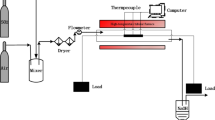Abstract
Corrosion is the main factor for steel failure. It is a natural process, which converts a refined metal to a more chemically stable form, such as its oxide, hydroxide or sulphides. It’s the gradual destruction of material (usually metals) by chemical and/or electrochemical reaction with the environment. For this study, the influence of temperature on the corrosion surface of the steel evaluated under the temperature that has been applied ranging between 40 and 110 °C for 2 min for the heat released by the material. The study of temperature absorption was conducted under low temperature between −17 °C until 15 °C for 2 min. This investigation of the experiment showed that the application of corrosion temperature behaviour of steel can be used or applied as the renewable application or purpose in the sector of engineering.
Access this chapter
Tax calculation will be finalised at checkout
Purchases are for personal use only
Similar content being viewed by others
References
Chen, Q., Wang, C., Sun, X., Cao, Y., Guo, T., Chen, J.: Evaluation and prediction for effect of conductive gussasphalt mixture on corrosion of steel bridge deck. Constr. Build. Mater. 228, 116837 (2019). https://doi.org/10.1016/j.conbuildmat.2019.116837
Dhole, G.S., Gunasekaran, G., Ghorpade, T., Vinjamur, M.: Progress in Organic Coatings Smart acrylic coatings for corrosion detection. Prog. Org. Coat. 110(January), 140–149 (2017). https://doi.org/10.1016/j.porgcoat.2017.04.048
Gonzalez, M., Nithiyanantham, U., Carbó-argibay, E., Bondarchuk, O., Grosu, Y., Faik, A.: Solar energy materials and solar cells graphitization as efficient inhibitor of the carbon steel corrosion by molten binary nitrate salt for thermal energy storage at concentrated solar power. Sol. Energy Mater. Sol. Cells 203(September), 110172 (2019). https://doi.org/10.1016/j.solmat.2019.110172
Liu, H., Cao, F., Song, G., Zheng, D., Shi, Z., Dargusch, M.S., Atrens, A.: Review of the atmospheric corrosion of magnesium alloys. J. Mater. Sci. Technol. 35(9), 2003–2016 (2019). https://doi.org/10.1016/j.jmst.2019.05.001
Loto, R.T., Olukeye, T., Okorie, E.: Synergistic combination effect of clove essential oil extract with basil and atlas cedar oil on the corrosion inhibition of low carbon steel. S. Afr. J. Chem. Eng. 30, 28–41 (2019). https://doi.org/10.1016/j.sajce.2019.08.001
Song, D., Hao, J., Yang, F., Chen, H., Liang, N., Wu, Y., Zhang, J., Ma, H., Klu, E.E., Gao, B., Jiang, J.: Corrosion behavior and mechanism of Cr e Mo alloyed steel: role of ferrite/bainite duplex microstructure. J. Alloy. Compd. 809, 151787 (2019). https://doi.org/10.1016/j.jallcom.2019.151787
Talbot, D.E.J., Talbot, J.D.R.: Corrosion Science and Technology, 3rd edn. Plenum Press, Boca Raton (2018). https://doi.org/10.1201/9781351259910
Wicker, M., Alduse, B.P., Jung, S.: Author’s accepted manuscript detection of hidden corrosion in metal roofing shingles utilizing infrared thermography. J. Build. Eng. 20, 201–207 (2018). https://doi.org/10.1016/j.jobe.2018.07.018
Acknowledgements
First and foremost, praise to God, without His blessing, this research would not be able to complete. All thanks to Almighty Allah, the compassionate and merciful, who knows about whatever is there in the universe, hidden and evident, and has enabled me to elucidate a drop from the existing ocean of knowledge. However, this research would not be completed without the kind support and help from Universiti Kuala Lumpur Malaysian Spanish Institute members and most of all Dr. Sharmiwati Binti Mohamed Shariff. Thanks to her for all the support and knowledge that has been given.
Author information
Authors and Affiliations
Corresponding author
Editor information
Editors and Affiliations
Rights and permissions
Copyright information
© 2020 The Editor(s) (if applicable) and The Author(s), under exclusive license to Springer Nature Switzerland AG
About this chapter
Cite this chapter
Sharmiwati-Mohammed-Sharif, Wan Zuharuddin, W.N. (2020). A Study on the Influence of Temperature on Steel Corrosion Over Time. In: Abu Bakar, M., Azwa Zamri, F., Öchsner, A. (eds) Progress in Engineering Technology II. Advanced Structured Materials, vol 131. Springer, Cham. https://doi.org/10.1007/978-3-030-46036-5_3
Download citation
DOI: https://doi.org/10.1007/978-3-030-46036-5_3
Published:
Publisher Name: Springer, Cham
Print ISBN: 978-3-030-46035-8
Online ISBN: 978-3-030-46036-5
eBook Packages: EngineeringEngineering (R0)




